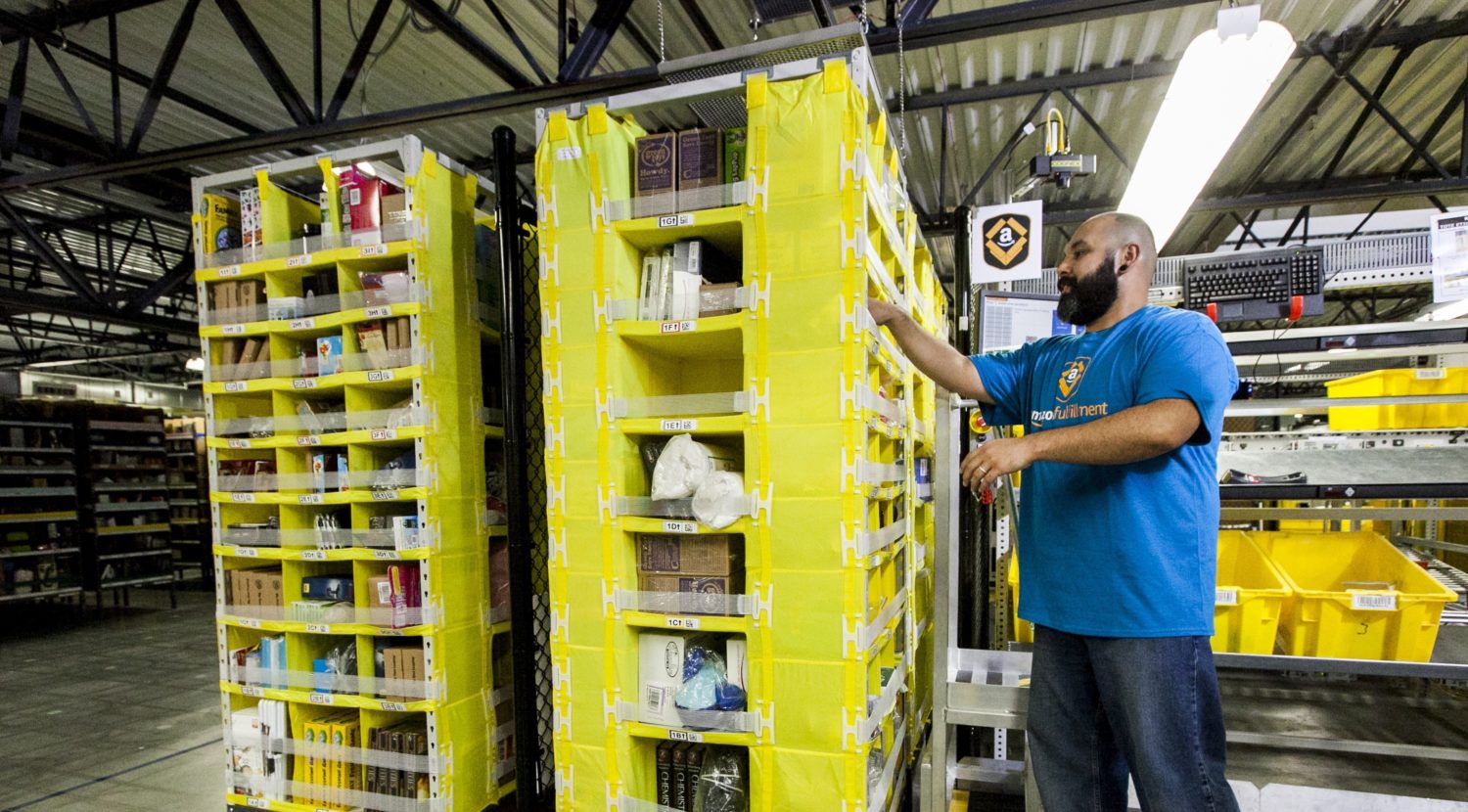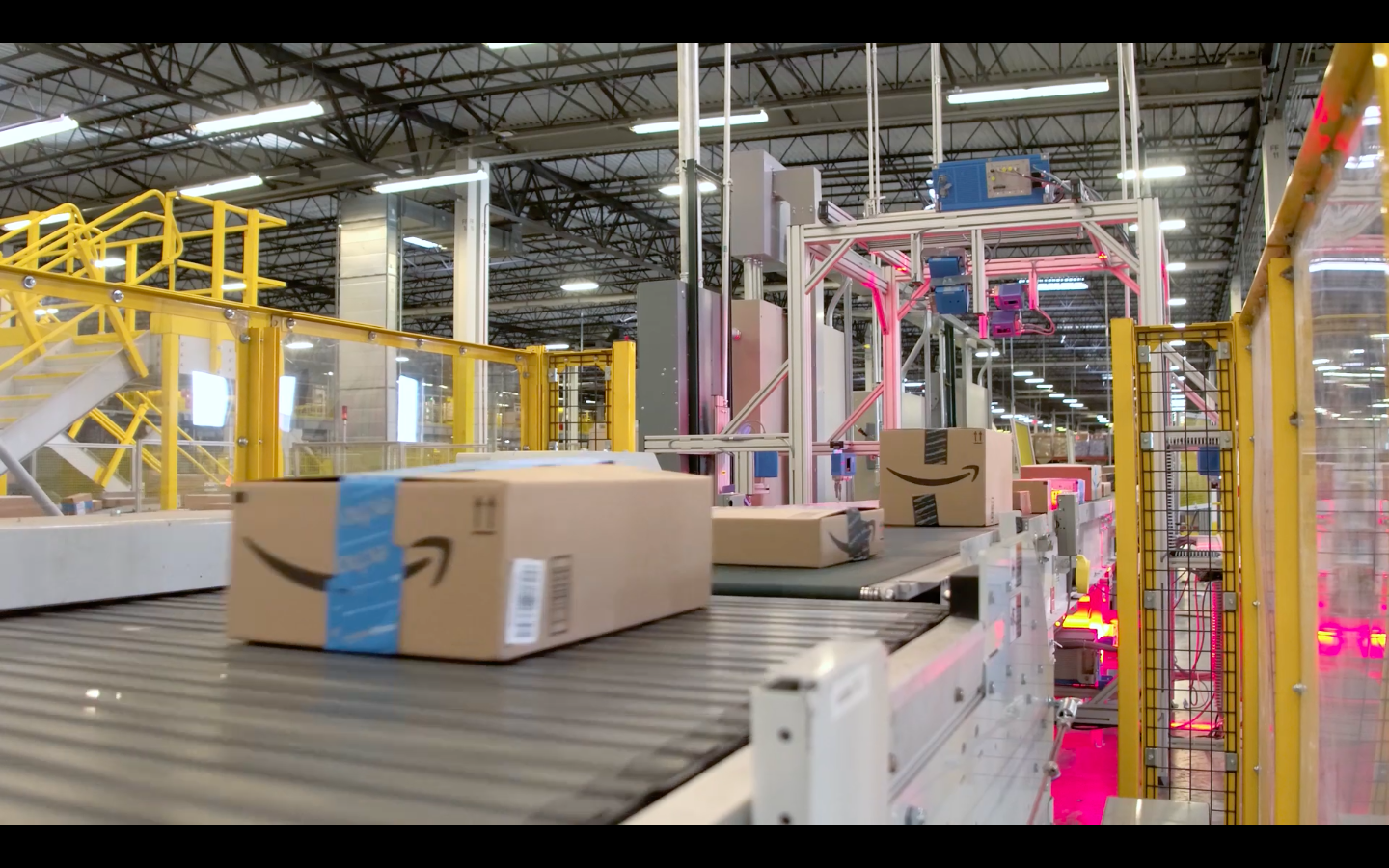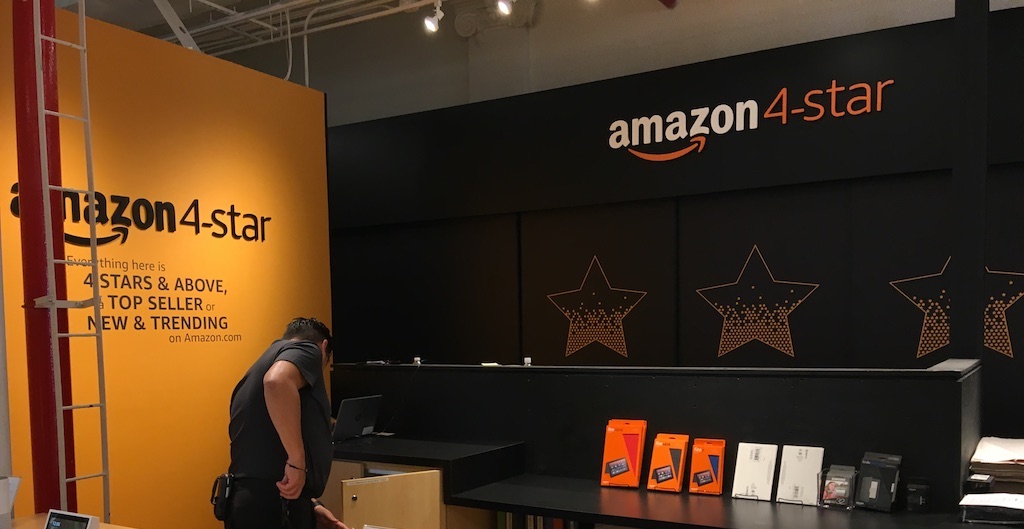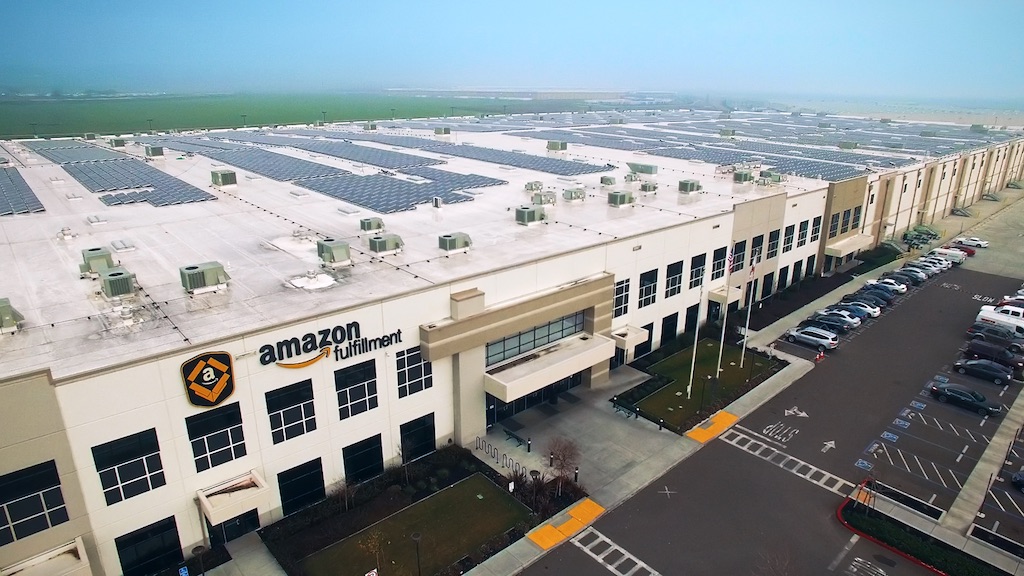
Amazon
One third of Amazon employees in Arizona need food stamps to feed themselves.
This story was published in partnership with The Intercept. We wrote a supplemental story about food stamps in the food industry here.
Later this year, Amazon will begin accepting grocery orders from customers using the Supplemental Nutrition Assistance Program, the federal anti-poverty program formerly known as food stamps. As the nation’s largest e-commerce grocer, Amazon stands to profit more than any other retailer when the $70 billion program goes online after an initial eight-state pilot.
But this new revenue will effectively function as a double subsidy for the company: In Arizona, new data suggests that one in three of the company’s own employees depend on SNAP to put food on the table. In Pennsylvania and Ohio, the figure appears to be around one in 10. Overall, of five states that responded to a public records request for a list of their top employers of SNAP recipients, Amazon cracked the top 20 in four.
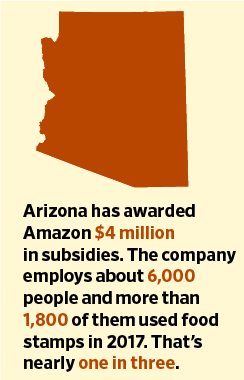
Sources: Amazon, Business Journals, State of Arizona
By 2021, Amazon is projected to handle 50 percent of all online sales in the United States. To accomplish this, it must add to the dozens of fulfillment centers that ensure the swift delivery of cheap televisions and shampoo bottles to nearly every corner of the nation. And to finance this expansion, the company will doubtless continue to leverage the promise of full-time jobs with benefits that it has used to win more than $1.2 billion in incentives from state and local governments so far.
However, though taxpayers have generously subsidized the build-out of Amazon’s warehouses, it’s not clear that the company has held up its end of the bargain. The jury is still out on its warehouses’ net effects on long term employment in the places they’re located. And independent analyses have shown that the company pays below-average wages for the warehouse jobs it brings to town.
The new data showing Amazon employees’ extensive reliance on SNAP demonstrates an additional public cost of the corporation’s rapid expansion. Even as generous subsidies help its warehouses turn a profit, its workers still must turn to the federal safety net to put food on the table. In Pennsylvania, for instance, an estimated $24.8 million in subsidies support 13 warehouses employing around 10,000 workers. At the same time, more than 1,000 of those workers don’t make enough money to buy groceries, according to public data provided by the state.
The American people are financing Amazon’s pursuit of an e-commerce monopoly every step of the way: first, with tax breaks, subsidies, and infrastructure improvements meant to lure fulfillment centers into town, and later with federal transfers to pay for warehouse workers’ food. And soon, when the company begins accepting SNAP dollars to purchase its goods, a third transfer of public wealth to private hands will become a part of the company’s business model.
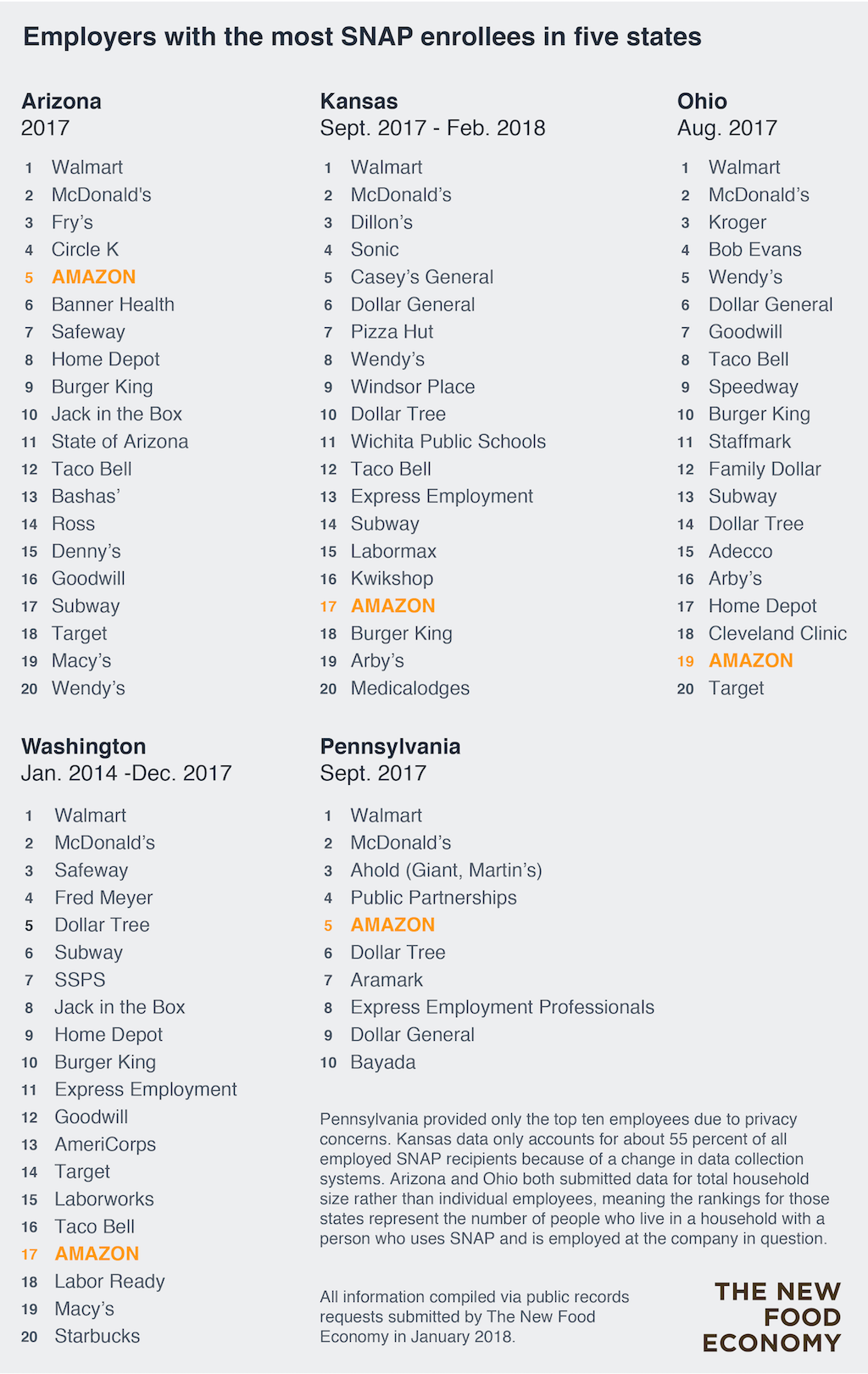
Ella Koeze
In January, after Policy Matters Ohio reported state data showing 1,430 Amazon workers and their family members enrolled in SNAP, the New Food Economy and The Intercept submitted public records requests to the 30 states we could identify with Amazon fulfillment centers. We requested information on employers with the largest number of workers enrolled in SNAP. We asked for data from the years 2014 to 2017 in hopes that several years’ worth of numbers would help us establish patterns in Amazon’s reliance on the SNAP program. All told, five states responded, and most sent in partial data that included either the year 2017 or a single month during that year. (Many states don’t track SNAP data by employer and are not required by law to generate new reports when public records are not readily available; some also cited privacy concerns in their refusals to grant our request.) Data from a sixth state, Ohio, was already publicly available.
“You have to ask yourself the question, ‘Is this game-changing?’”
In five out of these six states, Amazon cracked the top 20 list of companies with the most employees enrolled in the SNAP program. The numbers show that the company relies disproportionately on the program even accounting for its size: Amazon was the 28th largest employer in Arizona last year, but it ranked fifth for the number of employees enrolled in SNAP. It held the fifth slot in Pennsylvania as well, though it’s only the 19th largest employer. In Kansas, where Amazon isn’t even among the top 50 largest employers, it still ranked 17th for the number of employees using SNAP at the beginning of this year. Similarly, the company ranked 53rd in overall employment numbers in Ohio last year but 19th when it came to employees using SNAP. In Washington, where Amazon’s headquarters employ many white-collar workers, its employees were still the 17th most reliant on SNAP over the past four years.
Eligibility for SNAP is tied to more than just raw income, and states have wide latitude to administer the program according to federal guidelines. Household size, immigration status, asset ownership, and cost-of-living can all come into play when eligibility is determined. Some of the SNAP users working for Amazon are likely part-time employees, which would explain their low earnings. But the company claims that on average, more than 90 percent of its fulfillment center workforce is made up of full-time, direct hires.
Amazon’s rapid growth has obscured the reality of its impact on the communities that pay for the privilege of hosting its warehouses: Though the company now employs 200,000 people in the United States, many of its workers are not making enough money to put food on the table.

At an Amazon Jobs Day last summer, thousands of employees applied for fulfillment center positions
Amazon
When Amazon proposed a fulfillment center in Miami-Dade County last year, county officials anticipated the warehouse would bring 2,300 jobs at an average salary of $37,000. The company secured $1.5 million in tax rebates and a $5 million bond for infrastructure improvement largely based on these projections. But by the time negotiations concluded, the number of jobs necessary to qualify for the bond had been cut to 1,000, and salary expectations fell to $27,500, or $24,018 for jobs that included benefits. (The company had secured an exemption to the county’s usual requirement that projects receiving taxpayer-funded bonds provide “responsible wages.”)
“This started out with language like ‘game-changing,’” Miami-Dade Inspector General Mary Cagle told the Puget Sound Business Journal for a 2017 investigation of the company. “You have to ask yourself the question, ‘Is this game-changing?’”
The Business Journal spoke to officials in dozens of cities across the country who told similar stories about the company’s playbook: Amazon tends to “enter quietly, move fast, [and] pit sites against each other” to score generous subsidies.
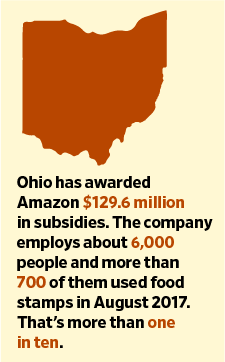
H. Claire Brown
Amazon initially built its business empire by exploiting a loophole that exempted it from collecting sales tax. As states began closing this loophole, Amazon switched tactics and focused instead on winning subsidies at the local level. When the New York Times investigated corporate incentives in 2012, Amazon had received $348 million from states and localities. By October 2017, when Business Journals released its findings, that number had more than tripled to $1.2 billion.
When companies receive government incentives, they might reasonably be expected to guarantee stable, well-paying jobs in return. But these incentives usually don’t come with such requirements. In a December 2011 report, the accountability think tank Good Jobs First analyzed state economic development programs. Its researchers found that fewer than half of the subsidy programs they looked at provided any type of wage standard for the jobs created.
To get its fulfillment centers built, Amazon capitalizes on a sense of urgency and competition to maximize the subsidies it receives. In doing so, it’s able to chip away at officials’ expectations for jobs and wages. Yet once the papers are signed and the warehouses are built, Amazon doesn’t appear to boost overall local employment. And the jobs it’s offering don’t look as good in reality as they do on paper.
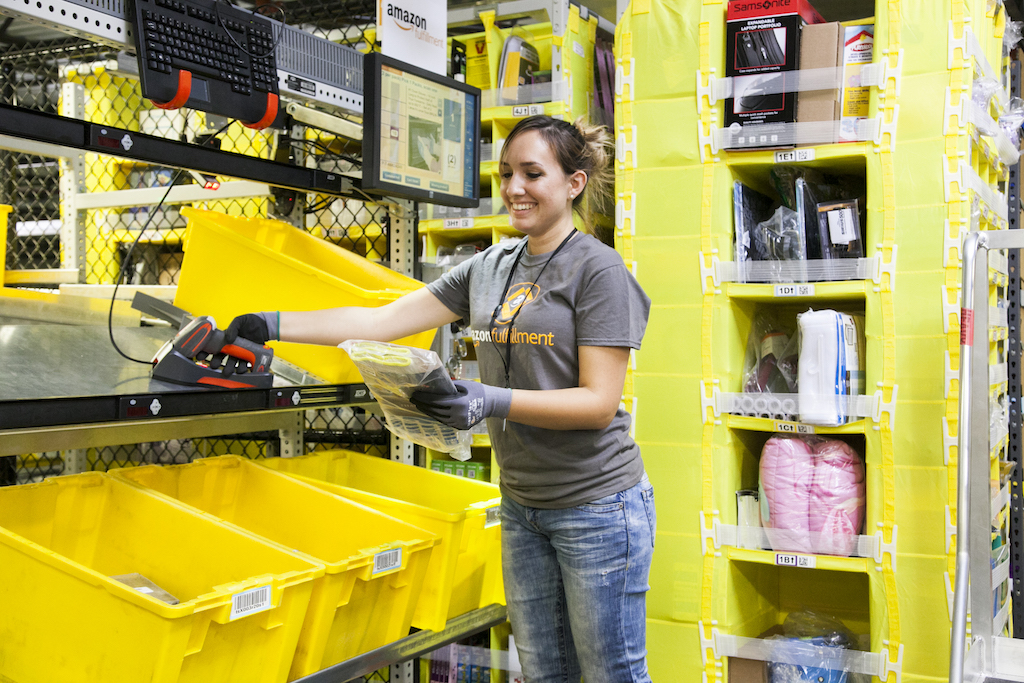
An employee picks products at an Amazon fulfillment center
Amazon
When Amazon announces it’s opening a new fulfillment center, it often trumpets the fact that its positions will pay up to 30 percent more than the average retail wage in the area. But as Good Jobs First researcher Kasia Tarczysnka points out, that’s a false equivalency. “They like to compare their warehouse jobs not to other warehouse jobs but to retailer jobs,” she said. “And traditionally warehouse jobs would pay a little bit more than retail jobs.”
Amazon disputes this, asserting that the pick-and-pack jobs it’s offering are more similar to retail work than warehouse work, in part because its fulfillment centers are temperature-controlled. A company spokesperson also emphasized that Amazon’s fulfillment center jobs are unskilled, whereas some traditional warehouse jobs require manufacturing skills.
Amazon’s fulfillment center wages are, generally speaking, lower than the average wages for warehouse employees elsewhere. “The average warehouse worker at Walmart makes just under $40,000 annually, while at Amazon would take home about $24,300 a year,” CNN reported in 2013. “That’s less than $1,000 above the official federal poverty line for a family of four.”
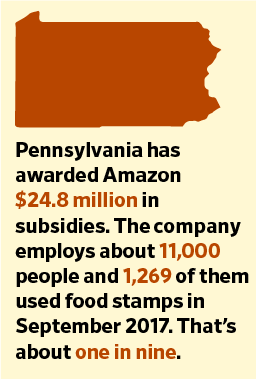
Sources: Amazon, Business Journals, State of Pennsylvania
A November 2016 study by the Institute for Local Self Reliance, a community development advocacy group, analyzed more than 1,300 wage postings on Glassdoor and found that positions at Amazon’s fulfillment centers paid about 9 percent less than the industry average. And when the researchers homed in on 11 major metro areas to account for differences in cost of living, they found that Amazon’s wage dip was even more pronounced: The company was paying 15 percent less than comparable positions in each area. A January 2018 study by The Economist using different methods found similar results.
An informal search of current job advertisements for full-time employees at Amazon fulfillment centers in states that responded to our inquiry corroborated this research. Starting pay ranged from $12 to $15 an hour. According to the Bureau of Labor Statistics, the average hourly wage for non-managerial employees who work in warehousing and storage was $17.53 as of January 2018. Even after stripping out the more lucrative warehouse positions that require skilled labor — forklift operators, for instance — pay for the lowest earners within the category, the people classified as “laborers and material movers,” still averaged higher than Amazon’s starting pay with a mean of $15.12 an hour.
Amazon has argued that its total compensation packages are competitive with the higher hourly rates of other companies’ warehousing jobs because of the benefits it offers to full-time employees. A company representative said that employees receive regular performance bonuses that augment their hourly pay, but she refused to indicate how much these bonuses might impact take-home wages in an average month. In response to a request for general comment about Amazon employees’ usage of SNAP in Ohio, the company reiterated some of these points in an email, emphasizing the fact that it provides health insurance, parental leave, and a program that helps pre-pay tuition for continuing education.
Amazon’s position is unique: It effectively paid no federal income tax in 2017 and has won more than $1.2 billion in incentives to build out its U.S. network.
But there’s a whole other class of fulfillment center employee without those benefit packages: temp workers. They wear different colored badges than the Amazon employees, but according to the ILSR report, they work side by side.
“Amazon says ‘seasonal,’ and some people say ‘temp,’ but in a lot of cases we’re talking about people working for Amazon who are working full days over an extended period of time,” said Olivia LaVecchia, a researcher for ILSR. “The only difference is they are not employed directly by Amazon. So Amazon gets off the hook for having no responsibility for them — legal and otherwise.”
Even though we can’t pin down precise numbers, temp workers’ presence in fulfillment centers is an important consideration if we’re trying to quantify Amazon’s total impact on the safety net. According to an analysis by the U.S. Department of Commerce, temp workers classified as “laborers and freight, stock, and material movers” made an average of $11.05 an hour in 2014, while direct hires made a mean hourly wage of $13.07. That means it’s likely they rely on programs like SNAP at higher rates than Amazon’s direct hires. Temp agencies appeared among the top 50 SNAP employers in every state that responded to our inquiry.
One temp agency in particular, Integrity Staffing Solutions, has called itself “a primary supplier to Amazon.” (The ILSR report refers to Integrity Staffing Solutions as a “human resources arm” of Amazon.) Integrity Staffing Solutions appeared as the 37th largest employer of SNAP recipients in Arizona. We can’t tell how many (if any) of those workers clock in at Amazon fulfillment centers, but Integrity’s presence on the list is a reminder that temp employees remain invisible even as the broader picture of Amazon’s reliance on the SNAP program comes into focus.

In five of six states, McDonald’s and Walmart were the top two employers of SNAP recipients
It’s no surprise that low-wage work often forces people to rely on public assistance to make ends meet. For the most part, the SNAP employer lists we obtained showed predictable trends: Walmart and McDonald’s fell in the top two slots in every state except one, and fast food companies in general were overrepresented. It’s also not particularly newsworthy that companies that generate a profit from the SNAP program also employ many people who rely on it. Walmart sees roughly $13 billion in annual revenue from SNAP, even as it tops the lists of employers whose workers rely on the program.
But Amazon’s position is unique: It effectively paid no federal income tax in 2017 and has won more than $1.2 billion in incentives to build out its U.S. network. Walmart, on the other hand, typically pays pretty close to the full corporate tax rate, meaning it certainly contributes much more than Amazon to the federal safety net that supports its customers and workers.
Our survey of just six states shows that Amazon ranks in the top 20 employers of SNAP recipients in nearly all of them, and those figures don’t include temp workers who likely rely on the program at even higher rates. These numbers are set against a backdrop of unprecedented growth: Amazon nearly doubled its total workforce from 300,000 to 541,900 between the third quarters of 2016 and 2017.
Amazon’s momentum shows no signs of slowing. On a single day last summer, the company attempted to fill 50,000 warehouse openings with dozens of jobs fairs across the country.
“What’s not great about a company that keeps building?” one applicant in Illinois asked a reporter for the New York Times.
After a five-hour wait, he left without a job.




